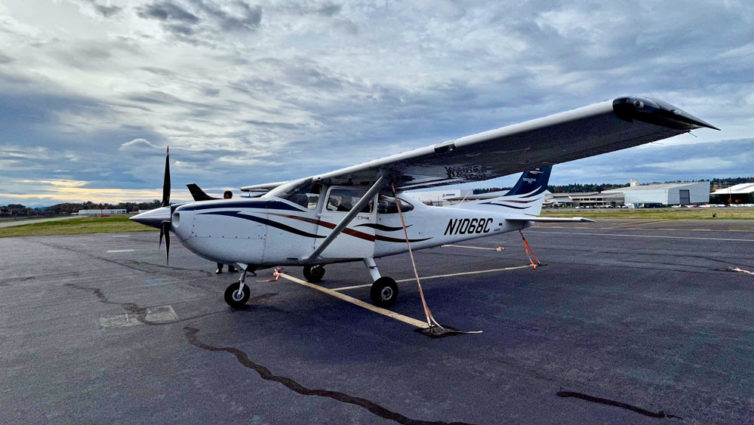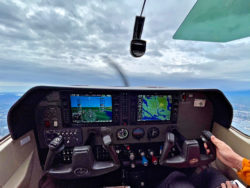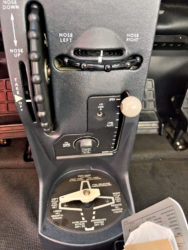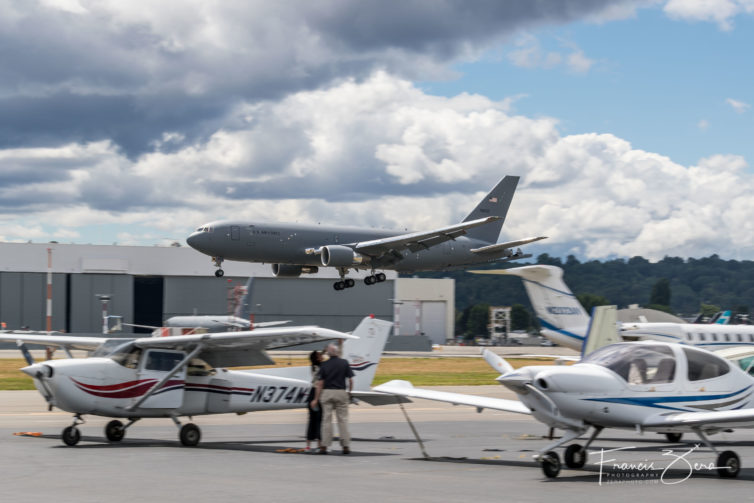
A Cessna 182T looks quite similar to a C172; it has a slightly larger cowling and a more powerful engine with a three-blade constant-speed propeller. It’s rated for 230hp vs 180hp in a 172SP.
Learning opportunities are endless in aviation, and that’s one of the best parts of being a pilot.
Seemingly no sooner did I get checked out in the Diamond DA-40 than Galvin decided to sell off both of their DA-40s. I do love to fly the C172, but I also adored the DA-40. Learning to fly that aircraft, which is more complicated than a C172 with its constant-speed propeller, set me up well to transition to the Cessna 182T Skylane, which has the same style propeller, albeit a three-blade version. The T in 182T stands for turbo, which does wonderful things for the plane’s performance as well as increases pilot workload a fair bit.
The turbo essentially makes the engine think it’s at or close to sea level all the time, which means performance doesn’t taper off with altitude as with naturally-aspirated engines. The tradeoff is that not staying on top of managing the engine temperatures makes it easy to damage the engine or the turbo due to the high heat generated by the turbo and its operation.
The 182T’s engine also has 50hp more than the C172SP I’ve been flying for a couple years now, 230hp vs 180hp. FAA regulations require a high-performance logbook endorsement from a flight instructor to fly aircraft with more than 200hp, so that’s also part of the checkout training for the 182T. Galvin’s house rules require a minimum of five hours flight training time with an instructor for this plane, plus a bit of ground training to be sure the pilot knows the aircraft systems and operating procedures.
- The C182T has a few more knobs and levers than the 172 to control the propeller and cowl flaps.
- These are the controls for trim, cowl flaps, and fuel
Besides being a bit faster than a 172, the 182T has a considerably greater load-carrying capacity and can fly much higher – 20,000′ vs 13,500′ for the C172. The 182T is equipped with a supplemental oxygen system for flying at high altitudes.
Despite all that, the 182T handles much like a 172, if a little nose-heavy due to the larger engine. This particular model has vortex generators on the leading edges of the wings and horizontal stabilizers. This makes it surprisingly difficult to stall. Carl (my very thorough and ever-patient CFI) had me fly it during a power-on stall such that the airspeed read zero on the indicator yet we were still flying and the stall hadn’t broken yet. Super fun.
There are additional controls to manage related to managing the propeller and engine and turbine-inlet temperatures. That makes things like takeoffs, landing approaches, and pattern work quite busy for the pilot, as there’s a lot of new stuff to learn. But with practice, it all becomes manageable.
I’m currently about halfway through the checkout process. The Pacific Northwest fall weather has made flying a game of last-minute weather cancellations. Once things clear up, the next step will be a cross-country flight to an airport I’ve not yet been to, around 100 miles away from Seattle. I have several routes planned out, and the exact choice will be driven by which has the best weather along the route. Stay tuned.


